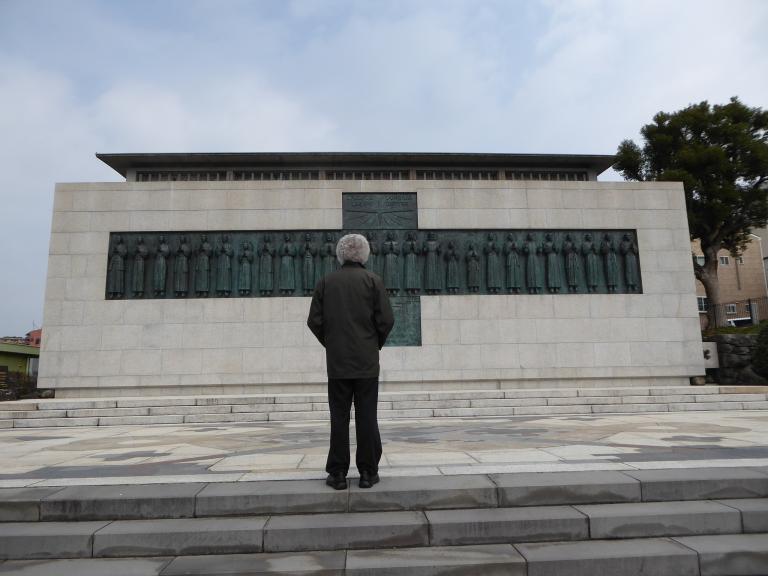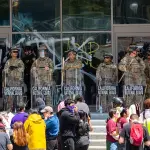Some days—September 11, December 7—forever stain our mental calendars, and this year March 11 joined those “days of infamy.” The date marked not only the one-year anniversary of COVID-19 being declared a pandemic but also the tenth anniversary of a tsunami that devastated a coastal region of Japan. The tsunami surge did its damage quickly and receded; the pandemic surge is still wreaking havoc across the globe.
The 2011 tsunami ranks as the most expensive natural disaster in history. Japan has spent three hundred billion dollars constructing sea walls, rebuilding roads, and replacing structures destroyed by the towering ocean wave. Meanwhile, a small army of workers still reports for work each day at the Fukushima nuclear power plant, trying to control contamination and prevent more catastrophic meltdowns.
I visited the area twice. The year after the tsunami, I met with some of the displaced families living in temporary housing and saw the relief work of Samaritan’s Purse and other Christian organizations. Six years later I returned with a pastor to visit his abandoned church in Fukushima, once a modern city and now an eerie ghost town. Each time, my hosts recited statistics of the damage caused in 2011: 410,000 cars destroyed, 19,000 people killed, half a million buildings badly damaged or destroyed.
Statistics don’t tell the human story, however. A local guide led me to an elementary school where 74 of 105 students died after school officials delayed instructing them to climb a hill just behind the school. Too late, the children were scrambling upward across snowy ground as the first wave hit, only to lose their footing and slip into the water’s certain death. Standing on the school steps, I watched a video recorded at that very vantage point, with the death-wave hurtling in and children screaming in the background.
A nearby gymnasium became an impromptu museum, housing children’s objects recovered from the mud and debris. For a year, volunteers painstakingly cleaned textbooks, dolls, coloring books, stuffed animals, school papers, scrapbooks, loose photos—any memento of the children who were lost. There I met a grief-stricken mother who was methodically sifting through the boxes full of debris. A year later, she was still coming to the gym, searching for some scrap that might have belonged to her daughter. Her image haunts me to this day.
In the early days of the pandemic I followed the charts of infections, hospitalizations, and deaths from COVID-19 as diligently as some people follow the stock market or sports scores. By any measure, the United States ranks as the worst-affected of any country, with our 5 percent of the world’s population accounting for 25 percent of cases worldwide and a fifth of total deaths. The statistics took on a different, more personal cast when my brother in California came down with the disease.
From my brother I got a daily, intimate account of what hospitalization has been like for almost 900,000 Americans so far. For two weeks he lay in an open ward, hardly sleeping because of the moans of others, some of whom were hallucinating. Hospital staff, shorthanded because of COVID, did their best to cope, but often his summons for help went unanswered. No visitors were allowed, and his only human contacts came dressed in full PPE garb. “I have nothing to read, and no TV. There’s nothing to do, and I can’t get any sleep,” he complained. He spent an additional two weeks in a rehab center, but during that time staff managed only three sessions of physical therapy. Every day he pleaded over the phone, “Please, help get me out of here.”
Later, I interviewed a chaplain at a memory care facility for patients suffering from dementia and Alzheimer’s. After losing twenty-two residents to COVID-19, the facility imposed a complete lockdown, banning visitors. “Where’s my family?” the puzzled patients asked. “Why doesn’t anyone come see me anymore?” The chaplain, Diane Kamin, sat with some of these confused residents as they died, holding their hands and offering whatever comfort she could. Sometimes she FaceTimed the scene to family members who were sitting in the lobby, awaiting their loved one’s imminent death. Then she would go out into the lobby and share every detail of the patient’s last hours on earth.
Listening to Diane Kamin, I thought back to a film I had seen by the journalist Malcolm Muggeridge, who profiled Mother Teresa’s work among the dying in Calcutta. Statistically, he admits, she did not accomplish much by rescuing stragglers from the streets. He concludes with the statement, “But, then, Christianity is not a statistical view of life.”
I have been reviewing the Gospels’ accounts of Jesus’ miracles of healing, wondering what we can learn from them in a time of pandemic or natural disaster. They record the details of two dozen individual instances of healing, covering a wide spectrum of disease and disability: blindness, deafness, leprosy, dropsy, paralysis, chronic hemorrhaging, fever, demon possession, a withered hand—and three incidents of resurrection from the dead.
Sometimes Jesus led mass events of healing in which he “cured many people of diseases and afflictions” (Luke 7:21). These seemed to drain him, and he would flee the press of the crowd to seek solitude in the hills, or row across a lake. He preferred the personal touch, one-on-one.
Jesus healed everyone who asked. Not once did he demur with an explanation like “Blind from birth? It’s too late to connect all those brain neurons” or “The man’s been dead four days—sorry, he’s beyond help.” Although Jesus had the ability to set right the worst ills that plague us, he chose against the spectacular remedies proposed by the Tempter in the desert. His miracles were on local scale, usually prompted by simple compassion, and often he asked that they not be publicized. Similarly, Jesus had the power to shout down a storm and tame the waves that were terrifying his disciples. But he did not alter the natural processes that would produce typhoons and hurricanes—and tsunamis—in succeeding centuries.
C.S. Lewis described the natural world as “a good thing spoiled.” The tectonic forces that proved so destructive in 2011 are the same ones that formed the islands of Japan in the first place. Viruses are the most abundant and diverse beings on earth, and virologists estimate that only 1 percent of them cause disease—yet just one mutant strain can bring the world to its knees.
Creation has been groaning “as in the pains of childbirth,” Paul told the Romans, having no illusions about the state of our planet. Our only hope is radical intervention, that one day “the creation itself will be liberated” in a sort of cosmic rebirth. Jesus’ miracles—especially the Resurrection—offer a tantalizing clue to that restored creation, though with no immediate solution to the suffering that afflicts us now.
A new book by Makoto Fujimura, Art and Faith, centers on the shortest verse in the Bible, “Jesus wept” (John 11:35), as a lens through which we can glimpse a new perspective on human suffering. Moved by the grief of Lazarus’s sisters, Jesus wept with them, even though he knew he would soon resolve that grief through a dramatic act of resurrection. Jesus also knew that the miracle was at best temporary, for Lazarus would ultimately die again.
A fantasy scene enters my mind, of Mary and Martha gathering around their brother’s bedside some thirty years after their encounter with Jesus. Lazarus is dying again, and their old grief returns. It’s different this time, though. They have no lingering bitterness against Jesus, for they watched in agony what he himself went through as part of the mystery of healing the planet. No, they’ve had three bonus decades with their brother, and not since he strolled like a mummy out of the cave have they doubted Jesus’ promise to return to the Father and prepare a place for them—and for us.
Oddly enough, they remember most acutely the image of Jesus bent over and leaning against the stone tomb, shaking with sobs. Though he knew the bright future that lay ahead, he understood that they did not. Rather than scold them for a lack of faith, he shared their tears. In a matter of days or weeks, they would share his tears too, for John 11 explicitly links the raising of Lazarus to the plot to kill Jesus.
I think back to the Japanese mother fumbling through boxes in a school gymnasium, weeping in that shy, unobtrusive Japanese way. Likely, she’s looking for stray belongings to place in her daughter’s bedroom, which she’s preserved intact since 2011. The school she’s sitting in has memorialized in permanent plaques the names of each child who died, as if they lived not seven or eight years but eternally. Whom we love, we humans keep alive in memory.
We cannot undo grief. Yet we can cling to hope that an omnipotent God has the power not only to keep us alive in memory but to resurrect us to a new and permanent state. “God weeps with us so that we may one day laugh with him,” says the theologian Jürgen Moltmann. Lazarus and Easter do not solve the problem of suffering, but they do point forward to a solution. Until then, Jesus weeps.














